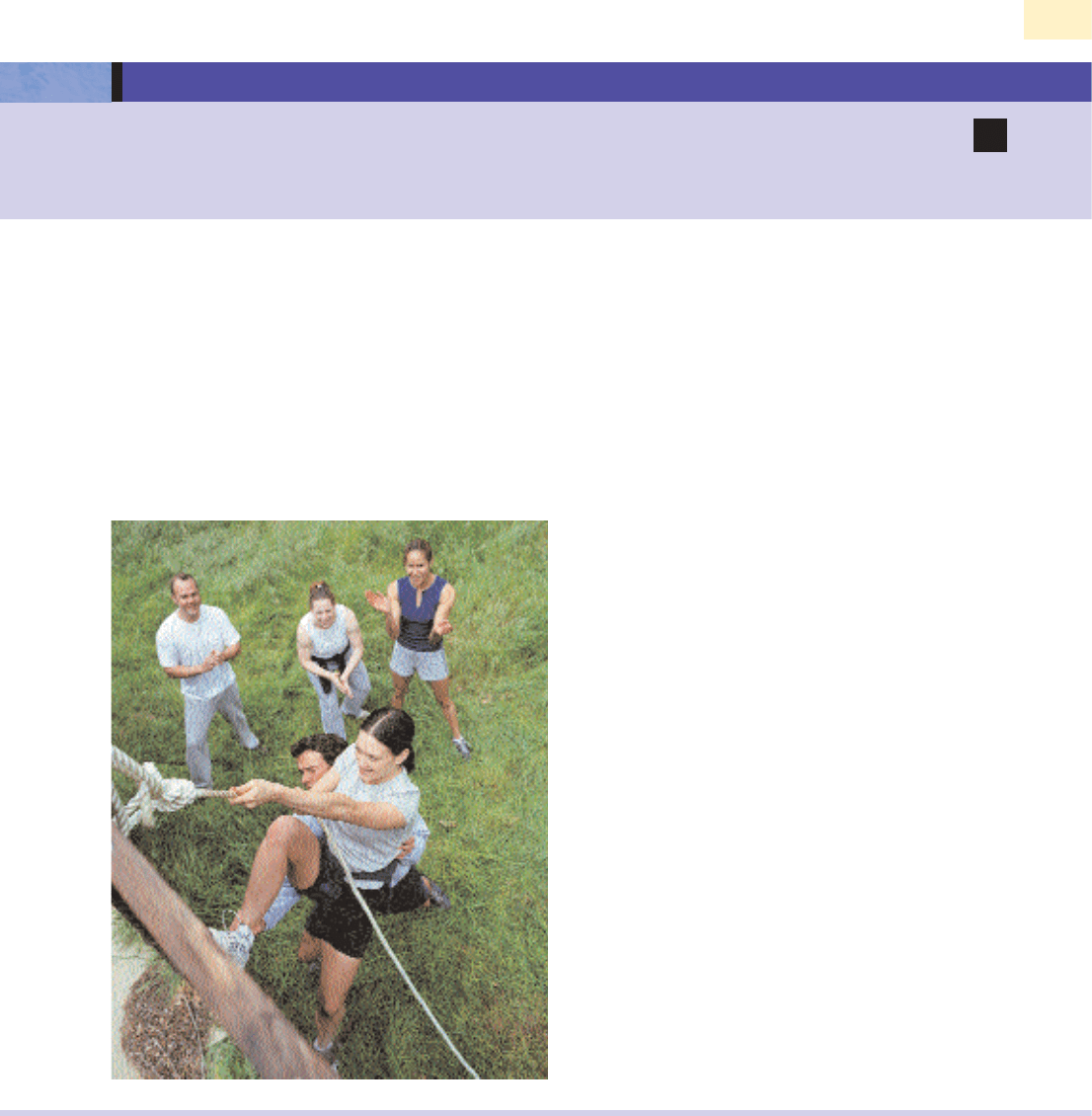Mullins L.J. Management and organisational behaviour, Seventh edition
Подождите немного. Документ загружается.


CHAPTER 14 WORKING IN GROUPS AND TEAMS
MANAGEMENT IN ACTION 14.2
Barriers come down to build up team spirit
585
Corporate executives who regard ‘team-building’ exercises as
a chance to let their hair down may well have paused for
thought following news that a Railtrack session led to the sus-
pension of a senior manager for allegedly drunken behaviour.
Yet the perception that corporate bonding events are a
well-earned opportunity to pop a few corks endures – and
catering for them is a booming business for hotels and man-
agement consultants, worth £600m a year.
Alcohol-fuelled antics at the Railtrack team-building exer-
cise last week allegedly outraged clients and staff at the
Balmer Lawn Hotel in Hampshire, and led to the suspension
of Paul White, head of national contracts.
Earlier this month, Jim Hodkinson lost his job as chief
executive of New Look, the fashion retailer, for groping the
bottom of a female colleague during a corporate event.
But Roland Ayling, general manager of Dunston Hall hotel
in Norwich, which regularly hosts company get-togethers, is
not surprised. ‘Of course, you get people becoming boister-
ous from drinking,’ he says. ‘That’s part of the day.’
Although some events may get out of hand, once out of
the office barriers come down as managers mingle with sec-
retaries. That is why companies are happy to spend often
large sums of money to help their employees get to know
each other better, in the belief that it will help them work
more efficiently.
‘During team-building events, employees will develop a
rapport which they have never had before,’ says Jason
Ludlow, of Events UK, which organised a team-building
treasure-hunting trek in the New Forest for Railtrack man-
agers last week.
However, not everyone agrees. Critics say few employees
bring back the newly found complicity to the office. ‘Nobody
ever forgets where the hatchet is buried,’ says one former
Marks and Spencer manager, who is a veteran of many
bonding sessions. ‘The sense of common purpose developed
during these exercises dissipates once it is subject to the
hurlyburly of everyday life at work.’
An advertising manager adds: ‘When people feel they are
under pressure to bond, they stay away from these events
and from one another afterwards.’
Popular team-building exercises include treasure hunting,
clay pigeon shooting and sailing. Some will be tailor-made to
reflect subtly a main corporate activity. For example, employ-
ees can be asked to help strangers in the street fix a tyre to
test customer service skills. Some managers question the rel-
evance of the games they have to play. ‘The fact that I can
build a raft to cross the river does not mean I can manage
people properly,’ says Edward Pickard who used to work at
Aon Corporation, the insurance brokerage, before joining
Tindall Riley.
(Reproduced with permission from the Financial Times Limited, © Financial
Times.)
FT
Photo: Jurgen Reisch/Getty Images

586
PART 5 GROUPS AND TEAMWORK
1 Discuss critically and with supporting practical examples the likely advantages and disad-
vantages of working in a small group or team.
2 Contrast different types of communication networks. Give examples of a situation in which
each type of network is likely to be most appropriate.
3 Assess the practical value to the manager of the analysis of individual behaviour. Explain
how you would go about constructing a sociogram.
4 Distinguish between: (a) group task roles; (b) group building and maintenance roles; and (c)
individual roles. Give your own examples of each of these types of group member roles.
5
Suggest a framework for the analysis and categorisation of patterns of individual behaviour in
group situations. What considerations need to be kept in mind when using such frameworks?
6 Explain what is meant by: (a) ‘groupthink’; (b) the risky-shift phenomenon; and (c) brain-
storming. Assess critically the likely standard of individual, compared with group or team
performance.
7 Explain the meaning and purpose of sensitivity training. Give your views on the relevance and
practical value of group dynamics.
8 Detail fully the main factors to be considered in a review of effective teamworking.
Attempt, preferably, to observe a small group or project team at work; alternatively, next time
you are involved in a small group discussion observe the members of your group.
a (i) Explain the nature of the content of the group’s discussion and contrast this with the
process of the discussion.
(ii) Complete the grid below by giving a tick in the appropriate box to denote the behaviour
of individual members in terms of:
– group task roles;
– group building and maintenance roles;
– individual roles.
b Explain the conclusions you draw concerning the conduct and apparent effectiveness of
the group.
ASSIGNMENT 1
REVIEW AND DISCUSSION QUESTIONS
Names of group members (or reference numbers)
Group task roles
Group building/maintenance roles
Individual roles
Totals
Totals

CHAPTER 14 WORKING IN GROUPS AND TEAMS
From your experience of working within a small group and/or project team at work, and as
directed by your tutor, attempt to undertake at least two of the following tasks.
TASK 1
Consider how individual members fit best into the Belbin’s revised nine team roles (Table
14.1, page 557).
Elaborate on both:
■ their specific team-role contribution; and
■ their allowable weaknesses.
Comment critically on the extent to which the people identified collectively help to form a bal-
anced and comprehensive list of team-roles.
TASK 2
Analyse the communication network(s) adopted and level of interaction among members
(Figure 14.2, page 559). Comment critically on the general level of satisfaction apparently
experienced by individual group members.
TASK 3
Classify individual member roles in terms of the amount of emphasis placed on:
■ task functions;
■ maintenance functions; and
■ self-oriented behaviour.
Comment critically on the overall structure or pattern of interrelations among members of the
group/team.
ASSIGNMENT 2
587

588
PART 5 GROUPS AND TEAMWORK
TASK 4
Using your understanding of Sociometry, provide in confidence to your tutor the names of
two people from your group/team with whom you would:
■ most prefer to accompany you on a ‘safari’ type holiday;
■ feel least uncomfortable in confiding to about a potentially embarrassing personal health or
hygiene problem; and
■ choose to discuss concern about progress on your course of study or at your place
of work.
TASK 5
Develop a list of critical indicators that you believe would best provide objective measures of
how successfully the group/team is performing and its contribution to the overall effective-
ness of the organisation.
Working within a small group, and as directed by your tutor, adopt a brainstorming approach
to providing as many uses as possible for:
■ a 1970 edition of an American 900-page textbook on management; and
■ a man or woman’s leather belt
Elect a member to record all of your responses. At the end of the allotted time delete any
obvious duplication, total the numbers of ideas for each separate exercise, and then be pre-
pared to share and compare with ideas and total scores from other groups.
What conclusions do you draw from this assignment?
Assignment 2 continued
ASSIGNMENT 3

CHAPTER 14 WORKING IN GROUPS AND TEAMS
OBJECTIVES
Completing this exercise should help you to enhance the following skills:
Analyse the range of roles that are necessary for most teams to work effectively.
Evaluate the role(s) you play within the team.
Identify which roles could be developed and used more to increase effectiveness.
EXERCISE
Referring to the 12 Roles Summary Sheet below, you are required to:
1 Complete the Team Role – Self Assessment Sheet.
2 Refine and validate the results by asking others who know you well to complete the Team
Role – Colleague Assessment Sheet for you.
3 Compare the results and instigate a discussion to understand the reasons for colleagues’
perceptions of you.
4 Observe the way in which people operate who are strong in the roles in which you are
weak and consider ways in which you can use your strengths to help others develop.
Rolessummary Sheet
PERSONAL AWARENESS AND SKILLS EXERCISE
589
Team leader Challenger Expert
Forms the team Adopts unconventional approaches Provides specialist expertise
Identifies strengths and weaknesses Looks afresh Acts as expert witness
Determines contributions Challenges accepted order Provides professional viewpoint
Monitors performance Provides the unexpected
Calls meetings Ideas man
Provides structure Challenges complacency
Reviews team needs Provides stimulus
Provides radical review
Ambassador Judge Innovator
Develops external relationships Listens Uses imagination
Shows concern for external environment
Evaluates Proposes new methods
Sells the team Ponders Evaluates ideas
Builds bridges Avoids arguments Nurtures ideas
Avoids advocacy Builds on others’ ideas
Promotes justice Visualizes opportunities
Avoids rushing Transforms ideas into strategies
Acts logically Deals with complex issues
Acts pragmatically Provides vision
Provides balance Provides ingenuity
Checks wild enthusiasm Provides logic
Seeks the truth Helps understanding
Diplomat Conformer Output pusher
Promotes diplomatic solutions Fills gaps Self motivated
Has high influence Co-operative
Preoccupation with output and results
Good negotiator Helps relationships ‘Drives’
Orientates the team Jack of All Trades Imposes time scales
Builds alliances
Avoids challenges to accepted order
Chases progress
Aids consensus Observes Shows high commitment to task
Pragmatic Conservative Intolerant
Sees way ahead Abrasive
Quality controller Supporter Reviewer
Checks output orientation Builds morale Observes
Preoccupation with quality Puts people at ease Reviews performance
Inspires higher standards Ensures job satisfaction Promotes regular review
Acts as team conscience Resolves conflicts Gives feedback
Shows relationship concern Gets to root of problem Acts as ‘mirror’
Gives advice Looks for pitfalls
Supports Is process-orientated
Encourages

PART 5 GROUPS AND TEAMWORK
Personal awareness and skills exercise continued
Team Role – Colleague Assessment Sheet
Referring to the descriptions on the Roles Summary Sheet place in rank order your per-
ception of how strongly the person plays each role.
Rank the strongest role 1 and the weakest 12.
12
34
56
78
910
11 12
Make remarks which you feel would be helpful in:
(a) Developing weak roles.
(b) Enabling the person to play roles which you feel would be helpful to the team.
590
Team Role – Self Assessment Sheet
Review the twelve roles outlined on the Roles Summary Sheet and rank them according
to the frequency with which you play each role.
12
34
56
78
910
11 12
Summary
Strong roles Weak roles

CHAPTER 14 WORKING IN GROUPS AND TEAMS
NOTES AND REFERENCES
1. ‘Teamwork: Success Through People’, Advisory Booklet,
ACAS, April 2003, pp. 6–7.
2. See, for example: Allcorn, S. ‘Understanding Groups at
Work’, Personnel, vol. 66, no. 8, August 1989,
pp. 28–36.
3. Guirdham, M. Interactive Behaviour at Work, Third edi-
tion, Financial Times Prentice Hall (2002), p. 463.
4. Obeng, E. All Change, Pitman Publishing (1994).
5. Crainer, S. Key Management Ideas: Thinkers that changed
the management world, Third edition, Financial Times
Prentice Hall (1998), p. 238.
6. James, J. Body Talk at Work, Judy Piatkus (2001), p. 211.
7. Belbin, R. M. Management Teams: Why They Succeed or
Fail, Butterworth-Heinemann (1981).
8. Belbin, R. M. Team Roles at Work, Butterworth-
Heinemann (1993).
9. Furnham, A., Steele, H. and Pendleton, D. ‘A
Psychometric Assessment of the Belbin Team-Role Self-
Perception Inventory’, Journal of Occupational and
Organizational Psychology, 66, 1993, pp. 245–61.
10. Arroba, T. and Wedgwood-Oppenheim, F. ‘Do Senior
Managers Differ in The Public and Private Sector? An
Examination of Team-Role Preferences’, Journal of
Managerial Psychology, vol. 9, no. I, 1994, pp. 13–16.
11. White, J. ‘Teaming with Talent’, Management Today,
September 1999, pp. 57–61.
12. Fisher, S. G., Hunter, T. A. and Macrosson, W. D. K.
‘The Distribution of Belbin Team Roles among
UK Managers’, Personnel Review, vol. 29, no. 2, 2000,
pp. 124–40.
13. Bavelas, A. ‘A Mathematical Model for Group
Structures’, Applied Anthropology, vol. 7, 1948, pp. 19–30,
and Bavelas, A. ‘Communication Patterns in Task-
Oriented Groups’, in Lasswell, H. N. and Lerner, D. (eds)
The Policy Sciences, Stanford University Press (1951).
14. Leavitt, H. J. ‘Some Effects of Certain Communication
Patterns on Group Performance’, Journal of Abnormal
and Social Psychology, vol. 46, 1951, pp. 38–50. See also:
Leavitt, H. J. Managerial Psychology, Fourth edition,
University of Chicago Press (1978).
15. Shaw, M. E. ‘Communication Networks’, in Berkowitz,
L. (ed.) Advances in Experimental Social Psychology, vol.
1, Academic Press (1964).
16. Moreland, R. L. and Levine, J. M. Understanding Small
Groups, Allyn and Bacon (1994).
17. Belbin, R. M. Changing The Way We Work, Butterworth-
Heinemann (1997), p. 13.
18. Stanley. T. J. ‘The Challenge of Managing a High-
Performance Team’, SuperVision, vol. 63, no. 7, July
2002, pp. 10–12.
19. Moreno, J. L. Who Shall Survive? Beacon House (1953).
See also: Moreno, J. L. and Jennings, H. H. The
Sociometry Reader, Free Press of Glencoe (1960).
20. Rogers, E. M. and Kincaid, D. L. Communication
Networks: Towards a New Paradigm for Research, The Free
Press (1981), p. 92.
21. Bales, R. F. ‘A Set of Categories for the Analysis of Small
Group Interaction’, American Sociological Review, vol.
15, April 1950, pp. 257–63.
22. Bales, R. F. Personality and Interpersonal Behaviour, Holt,
Rinehart and Winston (1970).
23.
Benne, K. D. and Sheats, P. ‘Functional Roles of Group
Members’, Journal of Social Issues, vol. 4, 1948, pp. 41–9.
24. Coghlan, D. ‘Managing Organizational Change
Through Teams and Groups’, Leadership & Organization
Development Journal, vol. 15, no. 2, 1994, pp. 18–23.
25. Whitfield, J. M., Anthony, W. P. and Kacmar, K. M.
‘Evaluation of Team-Based Management: A Case Study’,
Journal of Organizational Change Management, vol. 8,
no. 2, 1995, pp. 17–28.
591
DISCUSSION
■ To what extent do you agree with the list of 12 roles needed to make most teams effective?
■ Comment honestly and critically on your colleague’s team role assessment sheet. Did the
ranking surprise you?
■ What conclusions do you draw from this exercise?
Visit our website www.booksites.net/mullins for further questions, annotated weblinks,
case material and Internet research material.

592
PART 5 GROUPS AND TEAMWORK
26. Green, J. R. ‘Team Building in Practice’, Chartered
Secretary, November 1997, pp. 34–5.
27. James, J. Body Talk at Work, Judy Piatkus (2001), p. 212.
28. Kets de Vries, M. ‘Beyond Sloan: Trust Is at the Core of
Corporate Values’, in Pickford, J. (ed.), Financial Times
Mastering Management 2.0, Financial Times Prentice
Hall (2001), p. 268.
29. Douglas, M. ‘Why Soft Skills Are an Essential Part of
the Hard World of Business’, Manager, The British
Journal of Administrative Management, New Year 2003,
pp. 34–5.
30. ‘Teamwork: Success Through People’, Advisory Booklet,
ACAS, April 2003, p. 31.
31. Kravitz, D. A. and Martin, B. ‘Ringelmann Rediscovered:
The Original Article’, Journal of Personality and Social
Psychology, May 1986, pp. 936–41.
32. See, for example: Karau, S. J. and Williams, K. D. ‘Social
Loafing: A Meta-Analysis Review and Theoretical
Integration’, Journal of Personality and Social Psychology,
October 1993, pp. 681–706.
33. Hall, P. ‘Team Solutions Need Not Be the Organisational
Norm’, Professional Manager, July 2001, p. 45.
34. See, for example: Blanchard, K. and Bowles, S. High Five:
None of Us Is As Smart As All of Us, HarperCollins
Business (2001).
35. Stanley, T. J. ‘The Challenge of Managing a High-
Performance Team’, SuperVision, vol. 63, no. 7, July
2002, pp. 10–12.
36. Guirdham, M. Interactive Behaviour at Work, Third edi-
tion, Financial Times Prentice Hall (2002), p. 498.
37. Kogan, N. and Wallach, M. A. ‘Risk-Taking as a
Function of the Situation, the Person and the Group’,
in Newcomb, T. M. (ed.) New Directions in Psychology III,
Holt, Rinehart and Winston (1967).
38. For a comprehensive review of the ‘risky-shift’ phe-
nomenon, see, for example: Clarke, R. D. ‘Group
Induced Shift Towards Risk: A Critical Appraisal’,
Psychological Bulletin, vol. 76, 1971, pp. 251–70. See
also: Vecchio, R. P. Organizational Behavior, Third edi-
tion, Harcourt Brace and Company (1995).
39. Shaw, M. E. Group Dynamics, McGraw-Hill (1976).
40. Janis, J. L. Victims of Groupthink, Houghton Mifflin
(1972) and Janis, J. L. Groupthink, Second edition,
Houghton Mifflin (1982).
41. Hambrick, D. ‘Putting the Team into Top Management’,
in Pickford, J. (ed.), Financial Times Mastering
Management 2.0, Financial Times Prentice Hall (2001),
p. 289.
42. Osborn, A. F. Applied Imagination: Principles and
Procedures of Creative Thinking, Scribner’s (1963).
43. Diehl, M. and Strobe, W. ‘Productivity Loss in
Brainstorming Groups: Towards the Solution of the
Riddle’, Journal of Personality and Social Psychology, vol.
53, 1987, pp. 497–509.
44. See, for example: Bishop, S. and Taylor, D. Developing
Your Staff, Pitman Publishing/Longman Training,
(1994).
45. See, for example: Waterman, R. The Frontiers of
Excellence, Nicholas Brealey (1994).
46. Cooper, C. L. and Mangham, I. L. (eds) T-Groups: A
Survey of Research, Wiley (1971), p. v.
47. Luft, J. Group Processes: An Introduction to Group
Dynamics, Second edition, National Press (1970). (The
term ‘Johari Window’ was derived from a combination
of the first names of the original authors, Joseph Luft
and Harry Ingham.)
48. Davis, K. Human Behavior at Work, Fifth edition,
McGraw-Hill (1977), p. 183.
49. Davis, K. and Newstrom, J. W. Human Behavior at Work:
Organizational Behavior, Eighth edition, McGraw-Hill
(1989).
50. See, for example: McKenna, E. Business Psychology and
Organisational Behaviour, Lawrence Erlbaum (1994).
51. For an overview of experimental small group methods
and training needs, see, for example: Smith, P. B. Group
Processes and Personal Change, Harper and Row (1980).
See also: Brown, R. Group Processes: Dynamics Within
and Between Groups, Basil Blackwell (1988).
52. Wilson, J. ‘Building Teams – with Attitude’, Professional
Manager, September 1998, p. 13.
53. Browning, G. ‘Brain Food: Matters for the Mind to
Chew On’, Management Today, April 2000, p. 20.
54. Riches, A. ‘Emotionally Intelligent Teams’,
Organisational Change & Leadership Development,
www.anneriches.com.au, accessed 11 March 2003.
55. Teamwork: Success Through People. Advisory Booklet,
ACAS, April 2003, p. 34.
56. South African Employment Equity Act, 55, 1998.
57. Belbin, R. M. Management Teams, Butterworth-
Heinemann (1991); supported by a computer software
package used under licence from Belbin and Associates.
58. Misselhorn, H. J. Understanding and Managing your
Organization, M.O.D. Consulting (S.A.) (1998).
59. Misselhorn, H. J. The Head and Heart of Management,
M.O.D. Consulting (S.A.) (2003).
60. Experiential learning refers to the learning that occurs
from active first-hand involvement in the subject or
task to be learned, plus meaningful feedback to the
learner from successful and unsuccessful understand-
ing or performance.
61. These nine team roles were not developed from con-
ceptual models but based on empirical observations by
Belbin and his team over a number of years at Henley-
on-Thames Management College. The terms used help
to get away from the management jargon and find
words which capture, in layman’s language, something
of these typical behaviour patterns.
FT
Use the Financial Times to enhance your understanding of the context and practice of management and
organisational behaviour. Refer to articles 8, 14 and 15 in the BUSINESS PRESS section at the end of the
book for relevant reports on the issues explored in this chapter.

ORGANISATIONAL
STRUCTURES
Part 6
Part 2
THE
ORGANISATIONAL
SETTING
Part 3
THE ROLE OF
THE MANAGER
Part 7
MANAGEMENT
OF HUMAN
RESOURCES
Part 8
IMPROVING
ORGANISATIONAL
PERFORMANCE
Part 5
GROUPS AND
TEAMWORK
Part 1
MANAGEMENT AND
ORGANISATIONAL
BEHAVIOUR
Part 4
THE
INDIVIDUAL
Part 6
ORGANISATIONAL
STRUCTURES

How technology frees us from work
